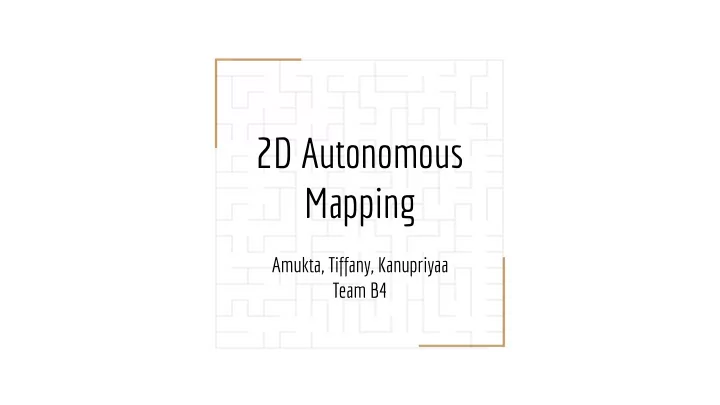

2D Autonomous Mapping Amukta, Tiffany, Kanupriyaa Team B4
Design Concept Need - Autonomous vehicles are often used to explore difficult to reach ● places (i.e. Search and Rescue, Scientific Exploration). Solution - This project aims to create a low cost, educational ● demonstration of autonomous mapping and navigation by building a vehicle that explores a simulated environment. Scope - Eliminate mechanical design challenges by reducing a real, ● textured environment to a static environment with smooth ground and flat walls. We will build a ground vehicle capable of producing a 2D map of the maze , traversing through it, and updating live changes to the maze ECE Areas : Software and Signals ●
System Specifications 1. Small wheeled vehicle capable of exploring an area with smooth surface. 2. Vehicle needs to traverse area above a minimum decided speed. 3. Must have a battery life of at least 2 hours. 4. Vehicle should keep track of map coverage (previously decided). 5. Software should be able to simultaneously do localization and mapping of the area. 6. Vehicle should travel efficiently without hitting any walls. 7. User must be able to start the vehicle from a webapp on a laptop. 8. User must be able to see the map being updated as vehicle moves.
SLAM Solution: SLAM (Simultaneous Localization and Mapping) built from ground up with these components: Mapping : Occupancy Grid Maps; Use graph-based search to mark explored nodes ● Sensing : Single Point Lidar (RPLidar A1 ~$150) ● Sensor mode : Raw data aka 2D point cloud ● Kinetics : Previous commands given + odometry data ● Loop closure : Using kinetics data ●
System Architecture Diagram Teleop
Electrical Schematic ● Lidar: RPLidar A1M8 (acquired) ○ 4 bytes per point (1 degree) ○ 1980 points / sec ○ Serial port baud rate 115200 ● Motor: 12V, 350 rpm DC motor + encoder ○ 229 ft / m ● Battery: Portable phone charger, 5V USB
Validation Plan Maze Design: 1 ft wide hallways ● Modular 1x1x1 ft sections, combined to form ● different maze configurations Phase 1 Testing: Build small maze with 4-6 sections to test basic ● navigation (without autonomous mapping function) Phase 2 Testing: Expand maze to 6x6 grid demo size ● Test map coverage on various configurations ●
Performance Metrict Metric Measurement Indicator Target Vehicle Speed Encoder, # map segments explored > 20ft/min Map coverage Grid map completeness (pixels) > 95% of map explored Efficiency # dead ends, # unnecessary paths revisited < 0, 2 maze segments Efficiency Time to complete maze mapping < 5 mins Localization Estimated to actual position distance < 1 in accuracy Battery Life Time passed with robot operating 2 hours continuously
Performance Metric Results Target Vehicle Speed > 20ft/min Max physical speed 234.5 ft/m Mapping speed 5.5”/sec -> 27.5 ft/min Map coverage > 95% of map explored NA Efficiency < 0, 2 maze segments NA Efficiency < 5 mins < 5 mins Localization < 1 in Accuracy under 1 inch, based on map resolution. accuracy Resolution can be higher but causes unnecessary use of memory. Battery Life 2 hours > 4 hours motors + rviz running
Project Management
Final Solution 6x6 ft configurable maze ● 11 3-sided “corner” segments ○ 25 2-sided “T” segments ○ Modular, compact design ● Completely wireless ● Live map visualization ● Rviz ○ Custom web application ○ Wireless teleoperated vehicle control ●
Lessons Learned Order parts ASAP ● Start integrating sooner ● PID motor control and calibrating ● odometry is hard
Recommend
More recommend